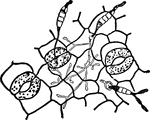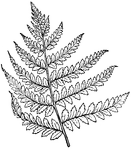Clipart tagged: ‘chlorophyll’

British Golden-rod
British Golden-rod is a member of the large composite genus Solidago, which is chiefly North American.…

Fungi
"In general, fungi are low plants which do not contain chlorophyll, in contrast with the algae, which…

Geum Urbanum
Geum urbanum is a member of the genus Geum, a genus of hardy plants (Rosaceae). Not usually used decoratively,…

Grass of Parnassus
A grass of Parnassus is any member of the genus Parnassia, of the Saxifrage family, growing in damp…

Lady Fern
The lady fern in the popular name of the fern 'Asplenium filix-foemina'. It is variable in size and…

Cross-section of a leaf
Cross section of a leaf, showing the breathing pores and intercellular spaces. The small dots are grains…

Raphides
This is an illustration of raphides, or acicular crystals, from the stalk of the Rhubarb: three of the…